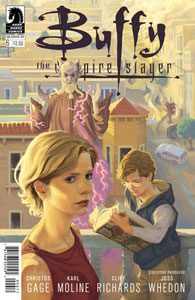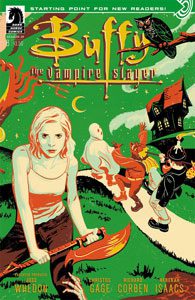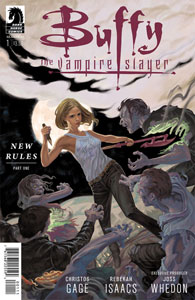After their strong run on “Angel & Faith” Season 9, writer Christos Gage and artist Rebekah Isaacs switch over to “Buffy” for the 30-issue Season 10. Off the bat, the quality of their work drops, as this season seems less planned out. The notion of the rules of magic being rewritten in the “Vampyr” book is a good one, but this idea doesn’t develop any new wrinkles. Characters warn about its “Monkey’s Paw” traits, using that exact reference several times. While this is a step down from Andrew Chambliss’ outstanding “Buffy” Season 9, it’s not bad, just slow out of the gates. Here’s my look at Issues 1-10:
“New Rules” (Issues 1-5, March-July 2014)
As he did with the finale of “Angel & Faith” Season 9, Gage juggles a lot of characters and information to launch “Buffy” Season 10. On one hand, the best Buffyverse stories are not the ones with gigantic casts and epic situations, but on the other hand, Gage – along with Isaacs – is good at telling large-scale stories that are easy to follow.
Nicholas Brendon chips in as a co-writer on Issues 3-5, making him the fourth Buffyverse actor to write for the comic (following James Marsters, Amber Benson and Juliet Landau). He’ll co-write a total of eight issues this season. If memory serves, “Buffy” under Gage’s (and sometimes Brendon’s) pen drifts toward quip-filled dialog, pop-culture references and general talkiness – similar to what happened to the TV series in its later years. This style seeps into “New Rules,” but not to the point that I can complain yet.
For instance, Andrew refers to people turning evil as “going all Dark Willow,” which annoys Willow, but then she says it herself, and – in a good example of a visual punchline from Isaacs – clenches her fist in annoyance at herself. This is too cute and funny for me to quibble.
A crazy but possibly juicy idea launches the season: Buffy and company can write the new rules of magic in the “Vampyr” book, which has blank pages since the destruction of the Seed in Season 8 and Willow’s creation of a new Seedling in Season 9. The book is self-writing naturally developing laws of magic – vampires can move about in the sun and morph into bats and wolves — but the Scoobies have the opportunity to shape details. After an initial misstep (which nearly leads to widespread disaster, natch), they are able to recast Dracula as no longer holding Xander – or anyone else — in his thrall.
It’s not often that Buffyverse stories venture beyond concepts that aren’t metaphors for real-world equivalents, but this is one such case. The Scoobies have godlike powers with “Vampyr.” Perhaps the closest parallel would be people starting religions in the old days, except in that case they need to manipulate people into believing what they write as Scripture. Another parallel that comes to mind is the “change it from the inside” trope, like when Angel and friends try to change Wolfram & Hart from the inside in “Angel” Season 5; in a way, the Scoobies oversee the supernatural world now.
Already changed on the inside is Dawn, who is physically healthy again but whose love of Xander has gotten erased. She has knowledge of everything that has happened in her life, but none of the feelings that go with the experiences. Meanwhile, Xander is seeing Anya’s ghost, or perhaps she’s a figment of his imagination (the ghost doesn’t know which it is either). Even as “Buffy” drifts toward bigger stories, it still has its eye on characters, particularly Xander and Dawn, the latter of whom was underused in the otherwise strong Season 9. I’m ready for a meaty Dawn arc.
4 stars

“I Wish” (Issues 6-7, August-September 2014)
The gang acquires new apartments in similar fashion to how Cordelia finds an affordable place in “Rm w/a Vu” (“Angel” 1.5). She lives with a ghost, whereas the Scoobies exorcise a demon for the building’s landlord in exchange for affordable rent. A “Friends”-like setup ensues, with Buffy, Willow and Dawn in one apartment; Xander and Spike in another; and Giles in another.
Before that can happen, though, they are sent to another dimension by the demon, at which point Gage revisits the premise of “After These Messages, We’ll Be Right Back” (Season 8, Issue 20) and Jane Espenson’s “Again” (“Tales of the Slayer, Vol. 2”). Everyone is sent back to their childhoods and they have to fight off those cozy, happy situations in order to return to reality. Throw in the fact that Cliff Richards – not as good at facial expressions as Isaacs — is on art duties (Karl Moline does only the first page, for some reason), and Issue 6 is relatively weak.
Issue 7 is better, with the good (albeit expected) humor that comes from Xander and Spike as roommates. I also like that the villains are sirens, female creatures who mesmerize men with their voices, a classic monster that hadn’t yet appeared in the Buffyverse. Beyond that, there’s nothing we haven’t seen before in “I Wish.” And aside from setting up the gang in new San Francisco digs, this is an inconsequential pair of issues.
3 stars

“Return to Sunnydale” (Issues 8-9, October-November 2014)
In addition to returning to the crater that was Sunnydale, “Buffy” returns to character-rich storytelling as Andrew aims to resurrect Tara by writing new rules in the “Vampyr” magic rulebook, thus making up for his part in Warren’s Trio. Willow stops him, having learned that resurrections are selfish acts by the living, not something that benefits the person who is in Heaven, as Buffy was and Tara is. (On the other hand, Giles is happy to be brought back … but let’s not overthink it.)
There’s also good writing here where Buffy says she recognizes the difference between pre-soul Spike and the current Spike, the same way she knows the difference between Angelus and Angel. I feel like we as fans don’t see that distinction in Spike as clearly as in Angel, largely because Spike – neutered by the Initiative’s chip – gradually exhibits more and more decent behavior sans soul in Seasons 4-6.
Also on the maturity front, Spike says he didn’t love Buffy before he had a soul; only now, when he wants what’s best for Buffy – even if it’s not a relationship with him — does he recognize true love. But it is interesting to note that his selfish love served him well as a pseudo-soul. Despite his lack of a soul in Seasons 5-6, it seems doubtful Spike would’ve harmed anyone Buffy cares about even if the chip had been removed.
Gage peppers these character notes amid a Soul Glutton attacking campers who celebrate Halloween on the lip of the Sunnydale crater, a good excuse for returning to the old stomping grounds. In a rare tactic by the comics, Issue 8 gives the backstory of the monster (with Richard Corben illustrating the beast’s tale), whose loved one is killed by an Aztec Slayer. Villain backstories are more common in the books, whereas TV episodes and comic issues are more likely to use monsters-of-the-week as metaphors or devices around which to tell the heroes’ story. The addition of the Glutton’s background doesn’t add a lot, but it doesn’t hurt to try something different.
On the quip front, I have to admit to another line I found funny. Willow notes that it’s a day where trouble is brewing, “or as we call it, ‘Wednesday.’ ” This is a variation on Buffy’s “Dawn’s in trouble; must be Tuesday” from “Once More, With Feeling” (6.7). “Buffy” aired on Tuesday, and new comics come out on Wednesdays.
For those interested in continuity, Season 10 takes place in 2011 at the earliest, as evidenced by Andrew using Siri on his smartphone to recite the resurrection spell. Elsewhere, a “Fifty Shades of Grey” reference backs that up; Siri and the “Fifty Shades” book debuted in 2011. That means Buffy is 30 in this season (as are her friends), and eight years have passed since the end of Season 7. (Note: Season 12 will later contradict this when Buffy states that she is 30 years old.)
4 stars

“Day Off (or Harmony in My Head)” (Issue 10, December 2014)
Another metaphor for the “Vampyr” book could be a governmental book of law, and like lawmakers, Buffy and Willow deal with lobbyists in Issue 10. After a parley with Vicki the vampire, Buffy and Willow agree to let the new vampires keep most of their powers. Vampires have political clout largely thanks to Harmony (who remains underappreciated on that front), and “Day Off” is her latest appearance.
This one is better than “In Perfect Harmony” (“Angel & Faith” Season 9, Issue 5), as Harmony recites to Clem all of her self-centered rules for the “Vampyr” book. He doesn’t write anything down, though, except “Unicorns are totally real.”
One Season 10 weakness that’s apparent through 10 issues is the lack of a compelling Big Bad. In “Day Off,” we learn that the lead siren, the Soul Glutton and a new villain called the Sculptor (who looks like a particularly disgusting golem) are plotting against the Slayer together. If they are to be the seasonal villains, they aren’t exciting choices, but I expect someone more interesting will emerge. If memory serves, the gang should be wary of D’Hoffryn, who represents a Magic Council regarding what should be added to “Vampyr.”
4 stars
Click here for an index of all of John’s “Buffy” and “Angel” reviews.


